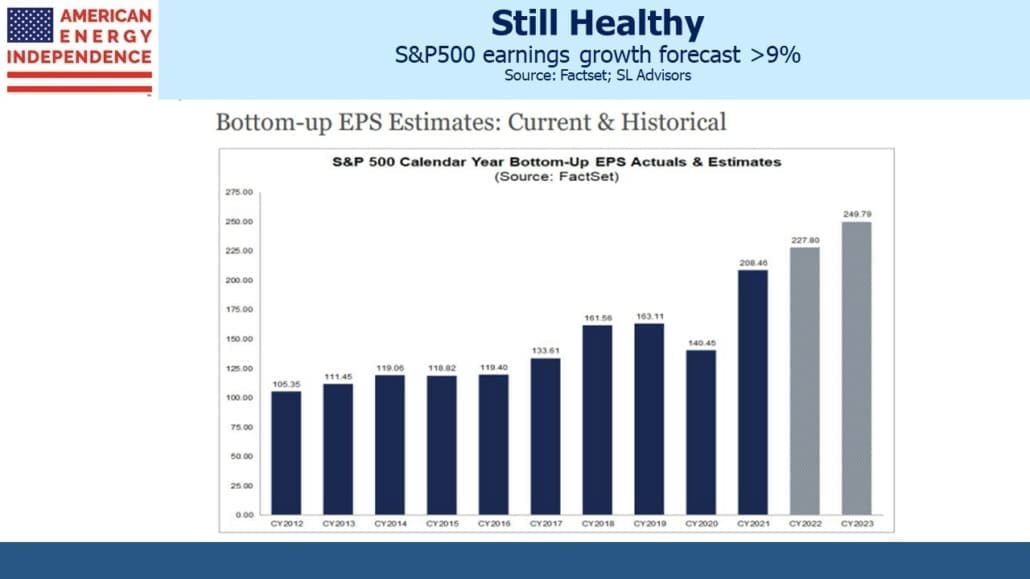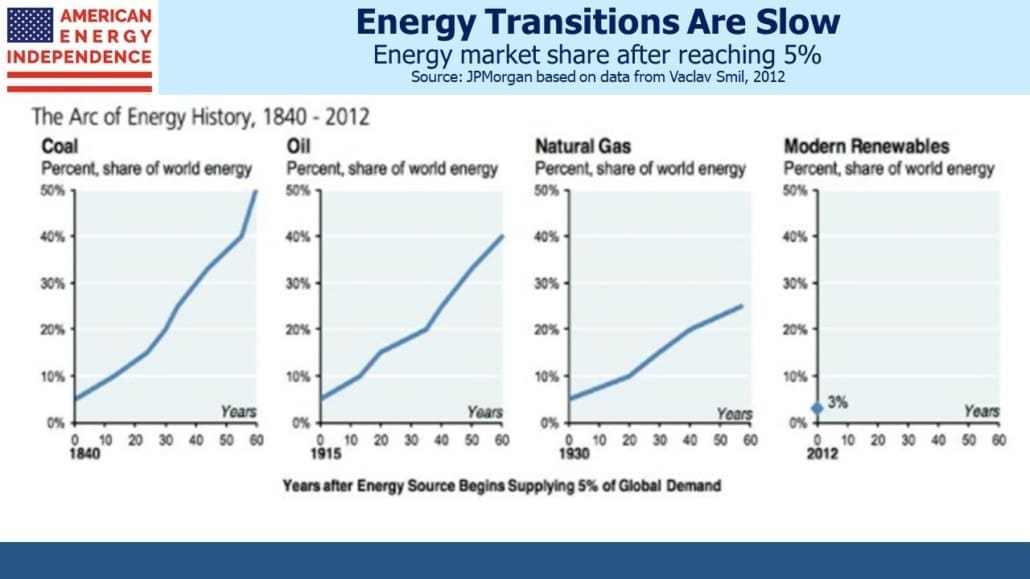The Fed’s Aspirational Base Case

/
There were few places to hide last quarter. The S&P500 was –4.6% with nine of its eleven sectors losing. Energy sparkled at +39% and Utilities were +4.8%. Bonds were even worse, with the Bloomberg Aggregate –6.2%. Close to our hearts, pipelines (as defined by the American Energy Independence Index) were +24.5%.
Low yields have underpinned stocks for many years, so a deteriorating Equity Risk Premium (ERP) is weakening the case for “TINA” (There Is No Alternative). Although bonds remain a long way from offering a fair return, yields have risen far enough that stocks no longer look compelling. Factset bottom-up estimates for S&P500 EPS growth are 9%, putting the ERP close to its 20 year average. As a successful and now retired bond trader used to say, 3% on the ten year note is only a nine iron away. This would make stocks look decidedly neutral.
Correctly calling interest rates is of greater import to one’s equity portfolio. JPMorgan produced an interesting chart that shows bond yields and equity returns are more highly correlated when rates are low. There’s no doubt low rates have driven investors to assume greater risk. Inconveniently, most of this relationship is since the Great Financial Crisis (GFC), so it’s unclear if the correlation has risen because rates are low, or because something changed structurally following the GFC. If ten year yields move above 3.6%, JPMorgan’s chart suggests the correlation will turn negative, meaning rising rates would be good for stocks. It’s hard to imagine, but inflation is changing many things.
Larry Summers and Bill Dudley are competing via erudite blog posts for the title of most articulate Fed critic. Dudley recently said that The Fed has made a U.S. recession inevitable thanks to its slothful removal of monetary support. Jamie Dimon said in his annual letter that “the medicine (fiscal spending and QE) was probably too much and lasted too long.”
Summers warned investors, The stock market liked the Fed’s plan to raise interest rates. It’s wrong. He took issue with the recently released FOMC forecast, which presents an impossibly optimistic outlook. He notes that the Fed is expecting inflation to moderate while pushing Fed Funds barely above their neutral target, all while maintaining close to full employment. Should Jay Powell and his FOMC colleagues pull this off, they will have threaded the proverbial needle and challenged economic orthodoxy. It’s more correctly an objective, or an upside case, rather than a forecast. No business could submit a budget with such hopeful outcomes.
This makes the future path of interest rates quite wide. If inflation doesn’t moderate, will the Fed push rates high enough to cause higher unemployment? How willing will they be to risk a recession? In August 2020 chair Powell revealed a subtle but significant change in how they regard their dual mandate of maximum employment consistent with stable prices.
Decades of declining real rates and an unemployment rate that continued to fall without causing wage pressures persuaded the Fed to allow inflation more upside than in the past. Since that symposium two years ago in Jackson their policy, “emphasizes that maximum employment is a broad-based and inclusive goal.” Data shows that minorities suffer employment more quickly than the general population, so the Fed is presumably now more sensitive to minority rates of unemployment. This isn’t necessarily a bad policy, but it is a modification and comes with increased tolerance for inflation.
The Fed now assesses “shortfalls” not “deviations” from maximum employment, since “employment can run at or above real-time estimates of its maximum level without causing concern.” And most notably, “following periods when inflation has been running below 2 percent, appropriate monetary policy will likely aim to achieve inflation moderately above 2 percent for some time.”
Both Dudley and Summers impose a traditional Fed policy function on today’s situation. That would regard our current inflation spike as a manifest policy error demanding a prompt response. By contrast, Powell has admitted that inflation is too high but has yet to concede a policy error. Their revised consensus statement allows for some inflation risk in pursuit of getting everyone a job, so 7.9% inflation is less of a mistake than if, say, Paul Volcker was in charge.
If the FOMC projections turn out to be correct, stocks will do very well. The risk for equities is that inflation doesn’t moderate as expected – will an FOMC stung by their error tighten too much in response? Or will they place greater importance on near term maximum employment, always waiting for another month of hopefully better data? It’s unclear, but if Larry Summers is right that the FOMC forecasts are short on “intellectual rigor and honest realism” the Fed’s fealty to their reinterpreted mandate will be tested.
Perhaps because we cover interest rates and energy markets, connections often leap out. It’s politically correct (even “woke”) to assume wildly unrealistic assumptions about renewables, because it suggests endorsement of the policies required. So JPMorgan includes a chart showing global primary energy from renewables reaching a 60% share by 2050 from under 5% today. Fossil fuel use collapses so that oil, gas and coal in aggregate are less than 20% of primary energy use in 2050 versus 78% today.
Because JPMorgan is not quite as idealistic as the chart suggests, an extensive footnote warns that it’s based on the Net Zero outlook from this year’s BP Energy Outlook. The Net Zero scenario, which isn’t BP’s central case, roughly aligns with the UN’s goals. In other words, it’s what many climate scientists believe should be happening, not necessarily what they expect. JPMorgan adds that forecasts are “not a reliable indicator of future performance.” In other words, it’s not their forecast.
Ten years ago JPMorgan published a series of charts based on work by highly regarded polymath Vaclav Smil on the slow pace of energy transitions. It took coal 60 years after reaching 5% to provide half the world’s energy. Oil and natural gas still haven’t reached that level and probably never will. The forecast that renewables will provide half the world’s energy within two decades is aspirational, and even less likely to be accurate than the Fed’s. Any serious effort to reduce emissions will use more natural gas instead of coal, increase nuclear power substantially and incorporate carbon capture. Improbable forecasts that are presented as Base Case are never good. Larry Summers would agree.
We have three funds that seek to profit from this environment:
Please see important Legal Disclosures.

Important Disclosures
The information provided is for informational purposes only and investors should determine for themselves whether a particular service, security or product is suitable for their investment needs. The information contained herein is not complete, may not be current, is subject to change, and is subject to, and qualified in its entirety by, the more complete disclosures, risk factors and other terms that are contained in the disclosure, prospectus, and offering. Certain information herein has been obtained from third party sources and, although believed to be reliable, has not been independently verified and its accuracy or completeness cannot be guaranteed. No representation is made with respect to the accuracy, completeness or timeliness of this information. Nothing provided on this site constitutes tax advice. Individuals should seek the advice of their own tax advisor for specific information regarding tax consequences of investments. Investments in securities entail risk and are not suitable for all investors. This site is not a recommendation nor an offer to sell (or solicitation of an offer to buy) securities in the United States or in any other jurisdiction.
References to indexes and benchmarks are hypothetical illustrations of aggregate returns and do not reflect the performance of any actual investment. Investors cannot invest in an index and do not reflect the deduction of the advisor’s fees or other trading expenses. There can be no assurance that current investments will be profitable. Actual realized returns will depend on, among other factors, the value of assets and market conditions at the time of disposition, any related transaction costs, and the timing of the purchase. Indexes and benchmarks may not directly correlate or only partially relate to portfolios managed by SL Advisors as they have different underlying investments and may use different strategies or have different objectives than portfolios managed by SL Advisors (e.g. The Alerian index is a group MLP securities in the oil and gas industries. Portfolios may not include the same investments that are included in the Alerian Index. The S & P Index does not directly relate to investment strategies managed by SL Advisers.)
This site may contain forward-looking statements relating to the objectives, opportunities, and the future performance of the U.S. market generally. Forward-looking statements may be identified by the use of such words as; “believe,” “expect,” “anticipate,” “should,” “planned,” “estimated,” “potential” and other similar terms. Examples of forward-looking statements include, but are not limited to, estimates with respect to financial condition, results of operations, and success or lack of success of any particular investment strategy. All are subject to various factors, including, but not limited to general and local economic conditions, changing levels of competition within certain industries and markets, changes in interest rates, changes in legislation or regulation, and other economic, competitive, governmental, regulatory and technological factors affecting a portfolio’s operations that could cause actual results to differ materially from projected results. Such statements are forward-looking in nature and involves a number of known and unknown risks, uncertainties and other factors, and accordingly, actual results may differ materially from those reflected or contemplated in such forward-looking statements. Prospective investors are cautioned not to place undue reliance on any forward-looking statements or examples. None of SL Advisors LLC or any of its affiliates or principals nor any other individual or entity assumes any obligation to update any forward-looking statements as a result of new information, subsequent events or any other circumstances. All statements made herein speak only as of the date that they were made. r
Certain hyperlinks or referenced websites on the Site, if any, are for your convenience and forward you to third parties’ websites, which generally are recognized by their top level domain name. Any descriptions of, references to, or links to other products, publications or services does not constitute an endorsement, authorization, sponsorship by or affiliation with SL Advisors LLC with respect to any linked site or its sponsor, unless expressly stated by SL Advisors LLC. Any such information, products or sites have not necessarily been reviewed by SL Advisors LLC and are provided or maintained by third parties over whom SL Advisors LLC exercise no control. SL Advisors LLC expressly disclaim any responsibility for the content, the accuracy of the information, and/or quality of products or services provided by or advertised on these third-party sites.
All investment strategies have the potential for profit or loss. Different types of investments involve varying degrees of risk, and there can be no assurance that any specific investment will be suitable or profitable for a client’s investment portfolio.
Past performance of the American Energy Independence Index is not indicative of future returns.








Leave a Reply
Want to join the discussion?Feel free to contribute!